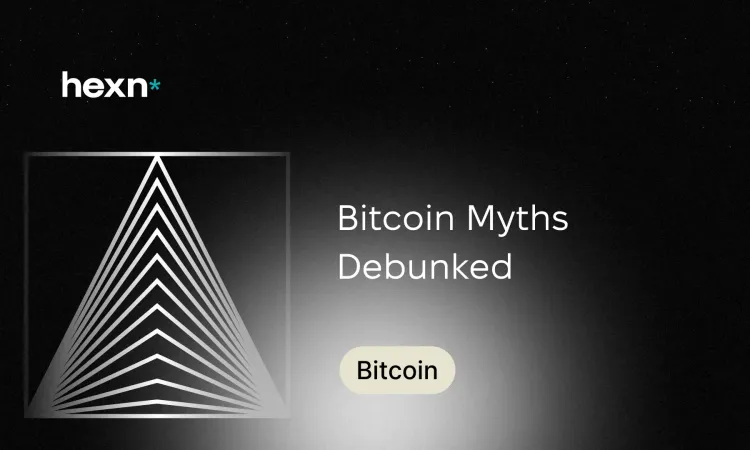Bitcoin Myths Debunked
Bitcoin is a digital currency that sparks curiosity and confusion. This guide explains what Bitcoin is and why clearing up common misconceptions helps both new users and experienced observers make better decisions.
Key Points to Remember
- Widespread awareness, persistent myths — many people have heard of Bitcoin but hold inaccurate beliefs about how it works.
- This article walks through 15 frequent myths and gives concise, practical explanations so you can separate fact from fiction.
15 Common Bitcoin Myths
Myth 1: Bitcoin Is Anonymous and Ideal for Criminals
Bitcoin addresses are pseudonymous, not fully anonymous. Every transfer is recorded on a public ledger, which means activity can often be traced back through transaction patterns, exchanges, and analytics tools. While bad actors have tried to exploit Bitcoin, the transparency of the ledger makes covert activity difficult to sustain over time.
Myth 2: Bitcoin Is a Ponzi Scheme
A Ponzi relies on new investors' money being routed to earlier participants by a central operator. Bitcoin is a decentralized protocol without a central manager who takes investor funds. Scams do exist in the crypto space, but labeling the entire network as a Ponzi conflates fraudulent schemes with an open monetary system.
Myth 3: Bitcoin Is Harmful for the Environment
Bitcoin mining uses significant electricity, which raises valid environmental concerns. However, the picture is nuanced: mining energy sources vary by region, and a growing share of operations use renewable or stranded energy. Comparisons to traditional financial infrastructure and power losses elsewhere are complex, and energy efficiency improvements continue to evolve.
Myth 4: Bitcoin Is Used by Technically Skilled People Only
Early tools were aimed at developers, but today's wallets, custodial services, and educational resources make Bitcoin accessible to nontechnical users. You no longer need deep technical knowledge to buy, store, or send small amounts, though basic security practices remain important.
Myth 5: Bitcoin Has No Intrinsic Value
Value can come from utility rather than a physical backing. Bitcoin offers scarcity, censorship resistance, and a decentralized settlement layer that can act as money across borders. These properties contribute to its perceived intrinsic worth for many users and institutions.
Myth 6: Bitcoin Is Too Volatile to Be Useful
Price swings are a reality, especially in developing markets. Volatility has tended to moderate as markets deepen and more institutions participate. For everyday transactions needing stability, fiat-pegged alternatives exist, while Bitcoin remains an option for long-term stores of value.
Myth 7: Bitcoin Will Burst Like a Bubble Soon
Bitcoin has experienced sharp cycles before, but it has also persisted through multiple corrections and continued expanding adoption. Calling it a short-lived craze overlooks its decade-plus track record and the real infrastructure and use cases that have grown around it.
Myth 8: Bitcoin Is Controlled by a Single Person or Group
Bitcoin runs on a distributed network of nodes and miners that enforce consensus rules. Protocol changes require broad agreement across the community. That distributed governance makes centralized control impractical, though influence can vary among stakeholders.
Myth 9: Bitcoin Is Mainly Used for Illegal Activity
Early headlines focused on illicit marketplaces, but most Bitcoin usage today is legitimate. The public ledger actually helps investigators trace wrongdoing, and many illicit transactions are intercepted or traced rather than hidden forever.
Myth 10: Altcoins Will Make Bitcoin Obsolete
Other cryptocurrencies offer different features, but Bitcoin benefits from a first-mover advantage and strong network effects. Those factors, along with broad recognition and liquidity, mean Bitcoin remains central even as new projects explore alternative designs.
Myth 11: Bitcoin Is Too Expensive for Average Investors
Bitcoin is divisible into very small units, so you can buy modest fractions rather than a whole coin. Modern platforms and wallets let people invest small amounts and build positions over time.
Myth 12: Bitcoin Transactions Are Always Slow and Costly
Main-chain fees can rise during congestion, but Layer-2 solutions and payment channels enable faster, cheaper transfers by settling off the main ledger. Ongoing protocol and ecosystem work aims to improve speed and reduce costs further.
Myth 13: Bitcoin Is Only a Speculative Gamble
Speculation is part of Bitcoin's market, yet it also provides utility as a censorship-resistant settlement system, a potential hedge in certain conditions, and a tool for financial access in regions with limited banking. Those use cases extend beyond pure speculation.
Myth 14: Bitcoin Is Just a Passing Trend
Over more than a decade, Bitcoin has developed a global user base, infrastructure, and diverse use cases. While the ecosystem will continue to change, the sustained interest from individuals and institutions suggests it is more than a short-lived fad.
Myth 15: Bitcoin Lack Real-World Applications
Bitcoin is used as a medium of exchange in some contexts, as a store of value in others, and as a backbone for remittances and cross-border settlement in specific corridors. Its ledger model also inspires supply chain and transparency solutions across industries.
Final Thoughts
Myths can distort judgment, so approach claims with curiosity and skepticism. Understand the technical basics, evaluate sources, and consider both risks and potential benefits before acting. Clear information helps you make informed choices in a fast-moving space.
